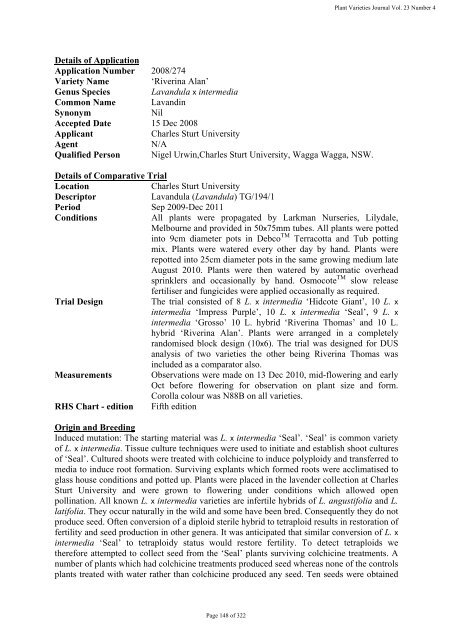Plant Variety Journal - IP Australia
Plant Variety Journal - IP Australia
Plant Variety Journal - IP Australia
Create successful ePaper yourself
Turn your PDF publications into a flip-book with our unique Google optimized e-Paper software.
<strong>Plant</strong> Varieties <strong>Journal</strong> Vol. 23 Number 4<br />
Details of Application<br />
Application Number 2008/274<br />
<strong>Variety</strong> Name ‘Riverina Alan’<br />
Genus Species Lavandula x intermedia<br />
Common Name Lavandin<br />
Synonym<br />
Nil<br />
Accepted Date 15 Dec 2008<br />
Applicant<br />
Charles Sturt University<br />
Agent<br />
N/A<br />
Qualified Person Nigel Urwin,Charles Sturt University, Wagga Wagga, NSW.<br />
Details of Comparative Trial<br />
Location<br />
Charles Sturt University<br />
Descriptor<br />
Lavandula (Lavandula) TG/194/1<br />
Period Sep 2009-Dec 2011<br />
Conditions<br />
All plants were propagated by Larkman Nurseries, Lilydale,<br />
Melbourne and provided in 50x75mm tubes. All plants were potted<br />
into 9cm diameter pots in Debco TM Terracotta and Tub potting<br />
mix. <strong>Plant</strong>s were watered every other day by hand. <strong>Plant</strong>s were<br />
repotted into 25cm diameter pots in the same growing medium late<br />
August 2010. <strong>Plant</strong>s were then watered by automatic overhead<br />
sprinklers and occasionally by hand. Osmocote TM slow release<br />
fertiliser and fungicides were applied occasionally as required.<br />
Trial Design<br />
The trial consisted of 8 L. x intermedia ‘Hidcote Giant’, 10 L. x<br />
intermedia ‘Impress Purple’, 10 L. x intermedia ‘Seal’, 9 L. x<br />
intermedia ‘Grosso’ 10 L. hybrid ‘Riverina Thomas’ and 10 L.<br />
hybrid ‘Riverina Alan’. <strong>Plant</strong>s were arranged in a completely<br />
randomised block design (10x6). The trial was designed for DUS<br />
analysis of two varieties the other being Riverina Thomas was<br />
included as a comparator also.<br />
Measurements Observations were made on 13 Dec 2010, mid-flowering and early<br />
Oct before flowering for observation on plant size and form.<br />
Corolla colour was N88B on all varieties.<br />
RHS Chart - edition Fifth edition<br />
Origin and Breeding<br />
Induced mutation: The starting material was L. x intermedia ‘Seal’. ‘Seal’ is common variety<br />
of L. x intermedia. Tissue culture techniques were used to initiate and establish shoot cultures<br />
of ‘Seal’. Cultured shoots were treated with colchicine to induce polyploidy and transferred to<br />
media to induce root formation. Surviving explants which formed roots were acclimatised to<br />
glass house conditions and potted up. <strong>Plant</strong>s were placed in the lavender collection at Charles<br />
Sturt University and were grown to flowering under conditions which allowed open<br />
pollination. All known L. x intermedia varieties are infertile hybrids of L. angustifolia and L.<br />
latifolia. They occur naturally in the wild and some have been bred. Consequently they do not<br />
produce seed. Often conversion of a diploid sterile hybrid to tetraploid results in restoration of<br />
fertility and seed production in other genera. It was anticipated that similar conversion of L. x<br />
intermedia ‘Seal’ to tetraploidy status would restore fertility. To detect tetraploids we<br />
therefore attempted to collect seed from the ‘Seal’ plants surviving colchicine treatments. A<br />
number of plants which had colchicine treatments produced seed whereas none of the controls<br />
plants treated with water rather than colchicine produced any seed. Ten seeds were obtained<br />
Page 148 of 322

















